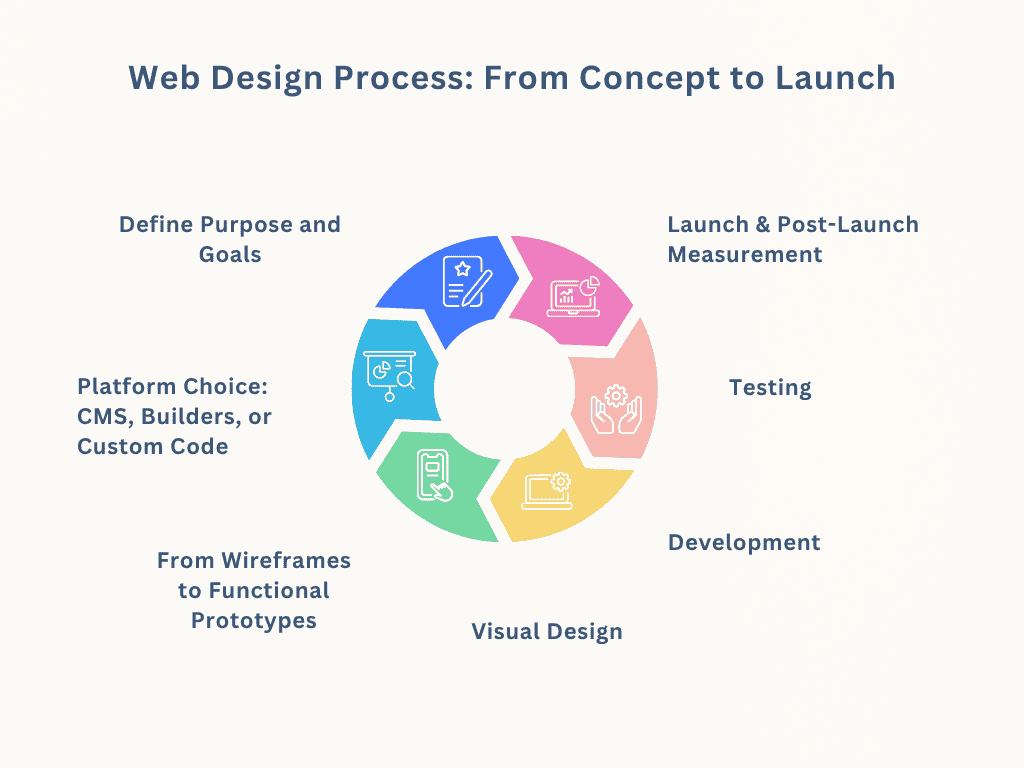A website often serves as the digital face of a business, shaping first impressions and influencing customer decisions. As digital behavior continues to evolve, today’s websites must do more than just look appealing; they must function seamlessly, load quickly, adapt to various devices, and provide a frictionless user journey.
Modern web design is no longer a luxury but a foundational element for any organization aiming to attract, engage, and convert visitors online. Whether you’re promoting a service, selling products, or building a digital portfolio, your website’s design can significantly influence your brand credibility, search visibility, and bottom-line results.
This comprehensive guide will explore the most essential design principles, the web design process, emerging trends, and strategies that businesses should embrace for long-term success.
What Is Modern Web Design and Why Does It Matter?
1. User Experience
Modern web design focuses on clean aesthetics, performance-driven layouts, mobile-first experiences, and user-centric interactions. It merges design with functionality to deliver not only a visually pleasing experience but also a highly usable and conversion-optimized one.
2. Role of Responsive Design
Understanding these principles enables teams to build scalable, efficient, and accessible digital products. Following a responsive web design approach ensures engagement across devices, which is essential for SEO and user retention.
3. Benefits of a Custom Website Design
Businesses embracing custom website design often find it easier to differentiate themselves in competitive markets. Comprehensive web design services also allow brands to focus on growth while design experts build the foundation.
Exploring the Latest Web Design Trends Shaping 2025
The latest web design trends are driven by shifts in technology and user expectations. Here are several modern web design trends 2025 to consider:
- AI-Powered Personalization
- Minimalist & Dark Mode Interfaces
- Voice & Gesture Interactions
- Sustainable Design
Why Trends Matter for Business Relevance?
Implementing these trends early helps businesses establish authority and build user trust. These principles are particularly useful in B2B web design services, where experience and clarity matter most.
Web Design Process: From Concept to Launch
Designing a high-performing website involves more than visuals; it’s a structured process that bridges creativity, strategy, and technology. Here’s a detailed walkthrough of the modern web design process from initial idea to final launch:

1. Define Purpose and Goals
Every successful web project starts by understanding why the website exists. Whether the goal is to generate leads, showcase a portfolio, sell products, or provide support, a clear definition of objectives will guide every design and development decision. Aligning business KPIs with user needs ensures the website serves both the organization and its visitors effectively.
2. Platform Choice: CMS, Builders, or Custom Code
Choosing the right platform is critical. Content management systems (CMS) like WordPress or headless CMS solutions offer flexibility and scalability. Website builders like Webflow or Wix suit smaller projects, while custom code is ideal for unique or highly complex digital solutions. Platform decisions should consider long-term scalability, content workflows, team experience, and integration needs.
3. From Wireframes to Functional Prototypes
The design blueprint begins with wireframes, basic structural layouts focusing on information architecture and user flow. Wireframes evolve into high-fidelity mockups that include branding elements, typography, and color schemes. Finally, interactive prototypes bring everything together to simulate real user interactions, enabling usability testing before development begins.
This stage allows for early feedback, reducing costly revisions later in the process.
4. Visual Design
Once the prototype is finalized, designers build a cohesive and engaging visual interface. High-quality images, meaningful iconography, and thoughtful micro-interactions enhance the user experience. These elements should reflect the brand’s personality and guide users toward key actions without distraction. A strong visual hierarchy, consistency, and accessibility are essential.
Designers now often use design systems and component libraries in Figma or Sketch to ensure design consistency and efficiency across pages.
5. Development
Development begins by translating designs into code using HTML, CSS, JavaScript, and preferred frameworks. Responsive design ensures compatibility across mobile, tablet, and desktop screens. Front-end development focuses on usability, animations, and layout, while back-end development handles server logic, content management, APIs, and databases.
Agile methodologies and version control tools help teams build iteratively and test continuously.
6. Testing
Before launch, the site undergoes rigorous quality assurance. This includes:
- Cross-browser testing (Chrome, Firefox, Safari, Edge)
- Responsive checks across devices
- Load speed and performance audits
- Accessibility validation (WCAG compliance)
- Broken link and SEO crawl checks
This ensures the website performs reliably for every user, regardless of device or platform.
7. Launch & Post-Launch Measurement
Once the website passes all QA checks, it’s launched to a live environment. However, the job isn’t over. Post-launch involves:
- Setting up analytics tools like Google Analytics or Hotjar
- Submitting the sitemap to search engines
- Monitoring performance and uptime
- Reviewing user behavior for optimization opportunities
It’s also important to recognize the distinction between web design vs web development when assigning responsibilities.
Strategic Website Layout Design for Business Growth
1. Designing for Attention and Flow
Smart website layout design guides users toward key actions. Converting visitors into leads or customers is crucial. Proven techniques include using grid systems for clean alignment, applying visual hierarchy through F and Z-patterns, and optimizing CTAs, whitespace, and scannability.
Businesses looking to stay competitive should prioritize modern web design in USA to ensure their layout strategies are aligned with evolving user expectations.
2. Strategic Layouts for eCommerce
Pairing this with custom website design ensures your layout supports your brand and business goals. If you’re offering products or services, eCommerce web design strategies like visual storytelling and optimized checkout flow become essential.
3. Improving Mobile and Accessibility
Strategic layouts also enhance mobile experiences, reduce bounce rates, and improve overall accessibility. When aligned with user intent, an optimized layout can significantly boost conversion rates.
Best Practices in Web Design for 2025
1. Performance and Mobile Optimization
To build an impactful website, it’s important to follow proven web design best practices. Prioritize page speed optimization, compress assets, and use a mobile-first strategy to ensure your site is responsive across all devices.
2. Accessibility and Semantic Design
Ensure WCAG compliance and semantic HTML to support accessibility, search engines, and future scalability. Artificial Intelligence Development can be considered the future of web design.
3. Scalability for Businesses of All Sizes
These practices ensure your site performs well and scales with user demand. They’re vital for website design for small businesses and growing brands. Larger enterprises can benefit from corporate website design services that combine branding with compliance.
Web Design vs Graphic Design: What’s the Difference?
1. When to Use Each Skillset
While they overlap, web design vs graphic design serve different functions:
-
Graphic Design:
Static visuals: logos, social media creatives
-
Web Design:
Dynamic, responsive interfaces focused on UX and interactivity
2. Collaborating Across Disciplines
It’s essential to work with both disciplines to achieve a visually appealing and functional digital experience. Be clear about your design needs to hire website designer with the right skill set.
Modern Web Design Trends 2025
Here’s a comparison table showcasing emerging modern web design trends and their key benefits:
Trend | Description | Key Benefit |
| Storytelling Through Interaction | Scroll-triggered animations and micro-interactions | Boosts engagement and retention |
| UX Driven by Real-Time Data | Use of behavioral analytics to inform UI/UX decisions | Enhances personalization and relevance |
| AI-Assisted Design Elements | Smart tools suggest layouts, colors, and typography | Speeds up the design process |
| Headless CMS Architecture | Decouples backend and frontend systems | Improves scalability and performance |
Staying agile with these tools improves iteration speed and enhances user engagement, especially when crafting solutions for B2B web design services.
These trends reflect a broader shift toward immersive, performance-focused web experiences. Staying current can give your brand a significant edge in building customer trust and loyalty.
Conclusion:
Investing in modern web design allows you to create compelling digital experiences that drive growth, retention, and trust. Understanding evolving trends and implementing efficient, scalable strategies can ensure your digital presence is future-ready. Whether you’re launching a new site or refining an existing one, combining custom website design with best practices ensures your brand stands out.
A well-structured, responsive website doesn’t just improve aesthetics—it boosts your credibility, supports marketing initiatives, and turns visitors into advocates. Explore our responsive web design guide or connect with our team to hire website designer and take your digital presence to the next level.

Partner with Experts
Frequently Asked Questions
What are the latest web design trends in 2025?









Modern trends include AI-driven personalization, modular design systems, immersive visuals, dark mode, and sustainability-focused performance optimization.
What is the ROI of investing in modern web design?
















A professionally designed website improves user experience, increases conversion rates, strengthens brand trust, and boosts SEO, delivering measurable business growth.
What role does UX/UI design play in modern web design?
















UX/UI design ensures a seamless, intuitive experience that guides users toward desired actions, increasing engagement and conversions.
What CMS platforms are best suited for modern web design?
















Popular CMS options include WordPress, Webflow, and headless CMS platforms like Strapi or Contentful for more scalable, flexible solutions.
What is the impact of minimalism in modern web design?
















Minimalist design improves clarity, load speed, and focus, helping users navigate content more effectively and reducing distractions.
How much does professional website design cost?
















Costs vary by scope and complexity but generally range from $2,000 to $20,000+, depending on features, customization, and agency expertise.
How long does it take to design a website?
















A typical web design project takes 4–12 weeks from discovery to launch, depending on the size, features, and revision cycles.



